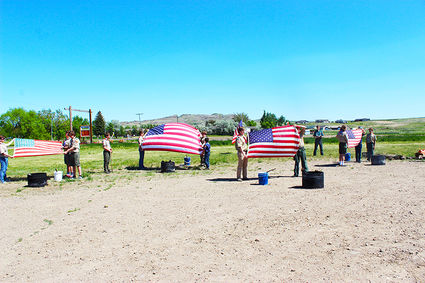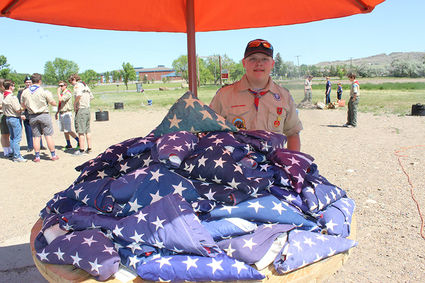More than 125 U.S. flags retired in local Eagle Scout ceremony
June 7, 2017

Steve Edwards Photo
As part of the retirement ceremony, Scouts unfold and display each flag before it goes into a fire pit. The flags are burned 'until no colors remain.'
On Memorial Day a group of Boy Scouts held a 'retirement ceremony' for 125+ U.S. flags that were no longer serviceable. The ceremony was part of an Eagle Scout project designed and carried out by Kougar Lanier. His idea for an Eagle project that would gather used flags to be "destroyed in a dignified way" was in large part based on inquiries from citizens to Scout troops about retiring flags. Lanier said, "I discovered there was no regular, ongoing process to retire U.S. flags." Lanier fashioned 'drop boxes' at several locations around the area, including the Blaine Country Courthouse, where flags to be destroyed could be left.
At mid-afternoon on Memorial Day, Lanier and Boy and Cub Scouts from all the troops in Havre gathered in a field next to The Bridge, a facility across the street from Havre High School used for various community events. Lanier said, "I liked the site because it is by a fairly busy street and we would attract people just driving by." Elks Lodge #1201, in Havre, helped with expenses of the Eagle project and several members were on hand to observe the ceremony. The weather was mild and cooperative.
About an hour before the 3 pm ceremony, several Boy Scouts were working to build and maintain fires in six fire pits. Kougar Lanier, who was keeping everyone on schedule and task, said, "The original plan was to have two fire pits, which would allow us to burn two flags at a time. When the number of flags exceeded 100+ we added four more pits and put out a call to the other troops for manpower." During the actual burning two to three Scouts were manning each pit.
At one corner of the field, where the fire pits were being prepared, there was a table with the flags to be burned. They were all properly folded and piled where the Scouts would be able to access them when the program began.
The ceremony for retiring flags
Lanier said there was no set schedule or required events that made up a flag retirement ceremony. Kougar and others created what they thought would be a dignified ceremony. At a few minutes before the 3 pm start, Lanier called the Scouts and audience to a moment of silence to observe National Moment of Remembrance. Then all the Scouts marched to the edge of the field and posted the flags. A Scout then led the entire assembly in the Pledge of Allegiance to the flag. That was followed by a prayer led by a Scout.
Then several Scouts, separately, came forward to share some facts and history of the U.S. flag. The whole idea of a flag began with the 1777 Flag Act, the first authorization by Congress for a national flag-the familiar thirteen stars and thirteen stripes representing the original colonies. The significance of the red, white and blue colors was also explained.
Since the original flag there have been 27 official versions to date-most having to do with adding stars for additional states admitted to the Union. In 1958, in a flag design competition, a Boy Scout's design was chosen from among hundreds of designs. The design was chosen by then President Dwight Eisenhower.
There is even a law in the U.S. Code that describes how a flag should be retired. Often referred to as the Flag Code, it states, "The flag, when it is in such condition that it is no longer a fitting emblem for display, should be destroyed in a dignified way, preferably burning." The "Scout Handbook" further suggests "The ceremony should be conducted with dignity and respect and the flag burned completely to ashes."
The burning of the flags
Before the ceremony Scouts and people in the audience were encouraged to write down names of deceased veterans who they would like to honor through the flag retirement. Those names were read by a Scout, then six groups of Scouts marched to the fire pits with a flag clutched by one Scout in each group. At the fire pits, on command, each team unfurled the flag, then put the flag into the fire-center first, then the edges pushed in. All during the time
the flags were being burned the Scouts stood at attention and saluted the flags. It took about three minutes for the flags to turn to ash, then six more flags were brought to the pits. To burn all the flags required about 20 cycles by the Scouts.
A Scout leader explained, "Kougar only planned to burn 102 flags given the number of pits and Scouts we had. Then we decided to go ahead and retire all the flags we had, which turned out to be more than 125." The ceremony to completely burn the flags took about two hours.
Future flag retirements

Steve Edwards Photo
Kougar Lanier, with Boy Scout Troop 1438 in Havre, stands with a pile of U.S. flags before they were burned as a part of a retirement ceremony on Memorial Day. More than 125+ flags were retired, about 30 from Blaine County.
Kougar Lanier said he was really surprised by the number of flags to be retired. He added, "We got a lot of press coverage about today's ceremony during the last few weeks and I think that helped increase the number of flags we gathered." Lowell Long, the commander of the American Legion in Chinook, was at the ceremony and he said about 30+ flags came from Blaine County.
Lanier has pledged to continue the program to have drop boxes for flags in various locations. The locations will be in Havre at the Holiday Mall, Anthony Cammon's State Farm Agency and at the Hill County Library. In Chinook the drop box is in the downstairs lobby of the courthous, next to the Sheriff's Office. As to plans for future flag retirement ceremonies, none are currently scheduled. But the need for regular flag retirement ceremonies is recognized.
The "Journal" thanks Kougar Lanier, and his fellow Scouts, for providing this service to their communities.







